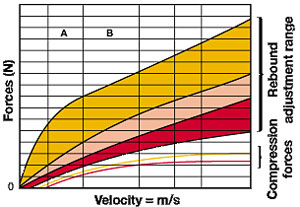|
KONI uses a variety of technologies: twin-tube low pressure gas-hydraulic dampers, twin-tube hydraulic dampers and mono-tube gas-hydraulic dampers. All these shock absorbers have typical properties which influence road behaviour of the car. The inappropriate use of pressurised shock absorbers may increase the ride-height which could affect the stability of the car and thus the safety. However, the handling of some cars may even improve by using these shock absorbers.  Therefore KONI does not simply supply pressurised shock absorbers for every type of car. Instead KONI chooses the technology which results in the best road holding, safety and comfort for each individual application. Therefore KONI does not simply supply pressurised shock absorbers for every type of car. Instead KONI chooses the technology which results in the best road holding, safety and comfort for each individual application.
When a shock absorber is compressed, the bump stroke, the piston rod moves inwards and displaces a proportional volume of oil. In case of a twin-tube damper the oil is forced through the foot valve system to the space between both tubes (the reservoir). The resistance thus produced is the bump damping force. During the rebound stroke the oil flows back again from the reservoir: the damping force is now produced by the valve system in the piston.
The twin-tube gas-hydraulic damper works in the same manner, but in addition to the oil, the reservoir is also filled with a quantity of gas. Thus, the interior of the damper is under a (relatively low) pressure.
High-pressure gas dampers are constructed differently. They are monotube dampers with oil and gas in one space, separated by a free-floating piston. Compressing the gas to a varying degree will compensate for the ever varying volume of the piston rod moving in and out.
These different damper constructions each have their own specific characteristics that can be of great influence on the road behaviour of the car. A 'random' application of gas-pressured dampers can increase the driving height of a car, negatively affecting it's stability. For this reason the KONI research engineers always opt for the technology that produces the best results for a specific car with regard to handling, safety and comfort.
Damping Characteristics And Adjustability - The characteristics of shock absorbers hardly ever get the attention they deserve despite the damper being responsible for comfort, roadholding, stability and safety. For instance, the shape of the damping characteristics when plotted on a graph is of great importance: the KONI experts emphasize this when developing.
This is a so called Force-Velocity diagram of a KONI damper. It shows the relation between damping forces and the speed of the damper in operation. When a car accelerates, brakes of rolls, typical damper speeds are in the (A) area.
Damper speeds caused by road surface irregularities usually are in the (B) area. Our engineers tune the damping forces in both ranges separately to a large degree. Their aim is an optimum balance between handling and comfort. Whereas Red KONI Special dampers are more biased towards comfort, yellow KONI Sportdampers are so towards handling.
KONI Adjustability - The diagram also clearly shows another unique feature of KONI dampers; their true full-range adjustability. This is essential, since adjusting only part of the characteristics disturbs good balance. The minimum value (full soft setting) is the recommended factory setting. When your driving style requires so, you can easily tune the suspension by adjusting the dampers. This makes your car respond even better but in the same time may change the comfort level. Therefore, we advise to make adjustments in small steps (half a turn) at a time and, of course, in equal amounts left and right.
KONIExternally Adjustable Dampers - These dampers are at the high-end of our range. They can be adjusted while remaining mounted on the car so that damping levels can be adapted to personal requirements in a matter of seconds.
KONI Sport vs KONI Special - The characteristics of shock absorbers hardly ever get the attention they deserve, despite the damper being responsible for comfort, roadholding, stability and safety.
Below is a force velocity graph of a KONI SPECIAL and a KONI SPORT shock, both designed for the same vehicle. The graph displays the adjustment ranges for both shocks. The pink area shows the adjustment range where both shocks are equal in value. The red area indicates that portion unique to the KONI Special, while the yellow area is specific to the Sport shock only.

When a car accelerates, brakes or rolls, typical damper speeds are in the (A) area. Damper speeds caused by road surface irregularities usually are in the (B) area. Whereas KONI Special dampers are more biased towards comfort, KONI Sport dampers are so towards handling. The shape of the characteristics is of great importance: the KONI experts use this information in development.
KONI Special (red) - The KONI Special dampers are designed to offer the best compromise between road handling and comfort. If only a Special damper is listed, its adjustment forces are designed for all driving requirements.
KONI Sport (yellow) - The KONI Sport dampers are designed for aggressive driving or cars with suspension upgrades while continuing to offer comfort. If a KONI Sport is listed as an alternative to the KONI Special, choose Sport for aggressive handling characteristics.
|

